UPSC Exam > UPSC Notes > Geography for UPSC CSE > Cheat Sheet: Drainage Systems
Cheat Sheet: Drainage Systems | Geography for UPSC CSE PDF Download
Key Terms (Flash Recall)
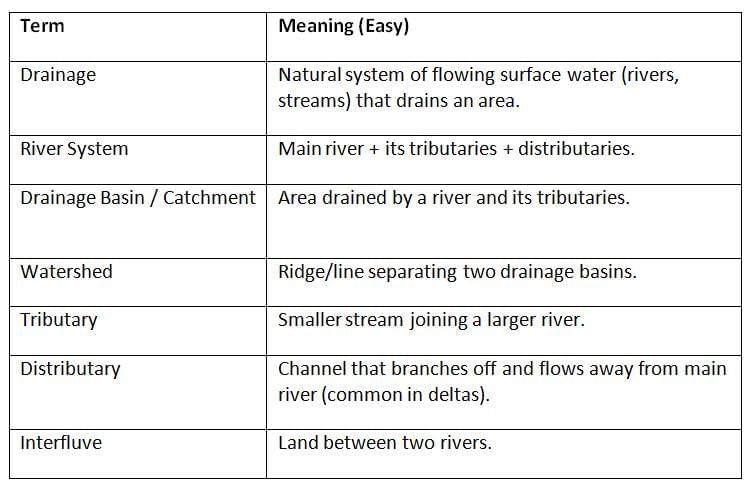
Drainage Patterns
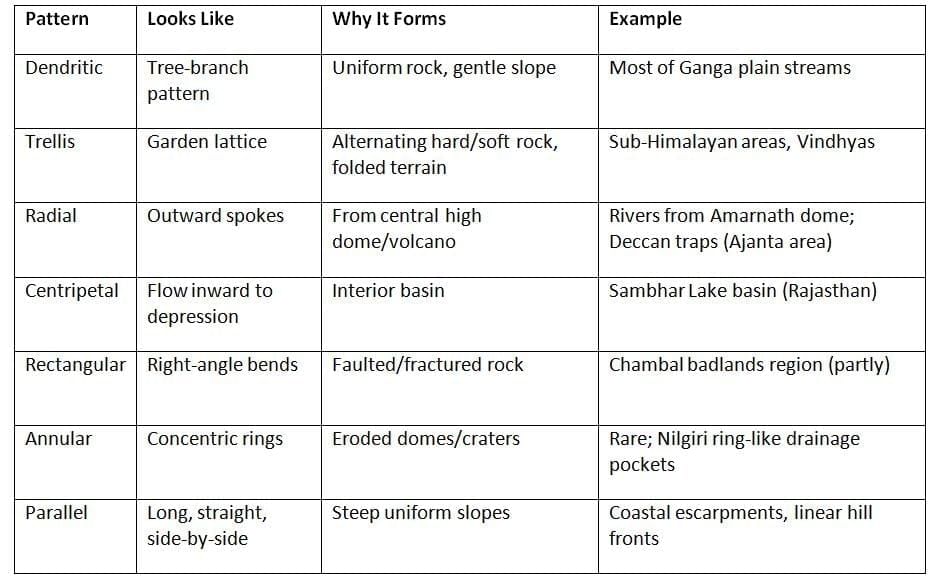
Prelims Tip: If options say “Alternating hard & soft strata” → mark Trellis.
River Course Stages (Youth → Maturity → Old Age)

Classification of Indian Drainage
A. By Origin
B. By Flow Direction
Mnemonic (East-flowing Peninsular): “Ma-Go-Kri-Ka” = Mahanadi–Godavari–Krishna–Kaveri.
Major River Systems of India
Indus System (Himalayan; International)
- Origin: Tibetan Plateau (Lake Mansarovar region).
- Flows through: Ladakh → Pakistan → Arabian Sea (Karachi coast).
- Main Tributaries (J & K / Punjab): Jhelum, Chenab (Jhelum+Ravi+Beas?), Ravi, Beas, Sutlej.
- Use in Exams: Indus Water Treaty; western rivers.
Ganga System
- Origin: Gangotri Glacier (Bhagirathi) + Alaknanda confluence at Devprayag = Ganga.
- Key Tributaries (L to R across plains): Yamuna, Ramganga, Ghaghara, Gandak, Kosi (flood-prone), Son.
- Delta Creation: With Brahmaputra → Sundarbans (world’s largest delta).
- Cultural hot belt: Haridwar, Varanasi, Prayagraj.
Brahmaputra System
- Upper Course Name: Yarlung Tsangpo (Tibet).
- U-turn: Enters Arunachal as Siang/Dihang, joins Dibang & Lohit → Brahmaputra (Assam).
- Nature: Braided, huge silt load, devastating floods.
- Delta with Ganga: Bangladesh (as Jamuna-Padma-Meghna system).
Peninsular Rivers (East-Flowing)
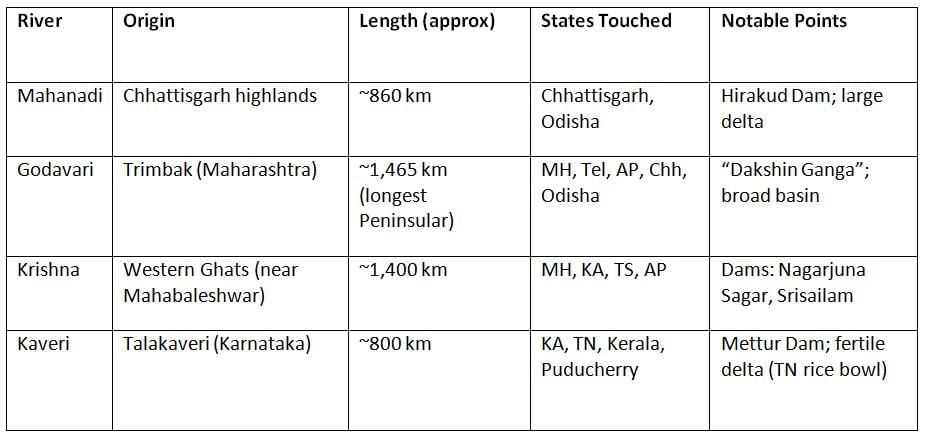
Peninsular Rivers (West-Flowing)
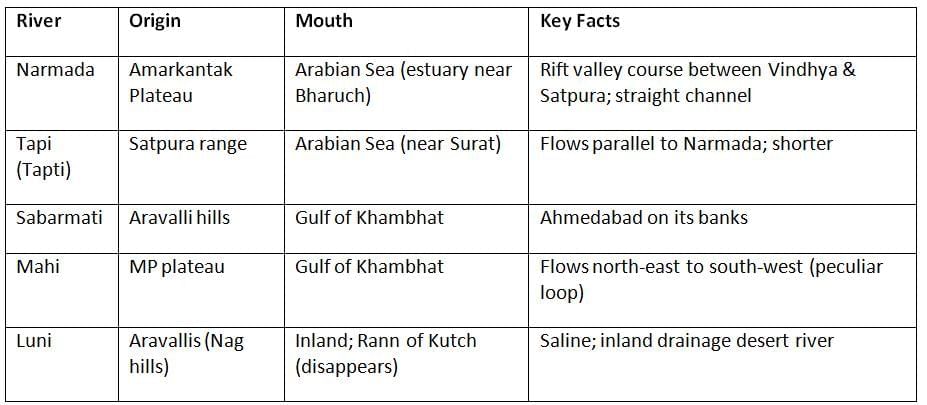
Inland Drainage in India
- Occurs where rivers do not reach the sea.
- Common in arid Rajasthan (Luni, Ghaggar-Hakra paleo-channel).
- Salt lakes form (e.g., Sambhar Lake).
River Processes & Associated Landforms)
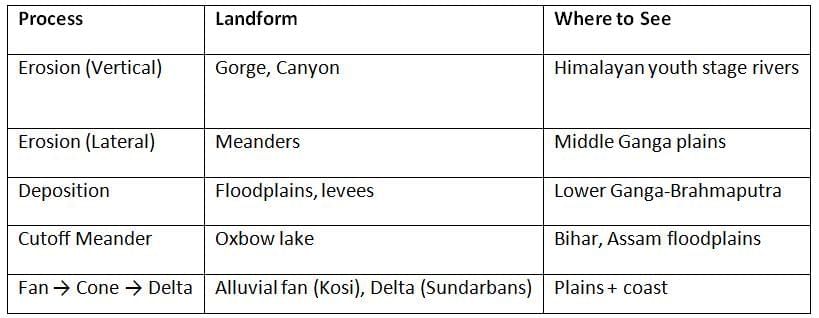
River Regime (Flow Variation Through Year)

The document Cheat Sheet: Drainage Systems | Geography for UPSC CSE is a part of the UPSC Course Geography for UPSC CSE.
All you need of UPSC at this link: UPSC
|
263 videos|875 docs|232 tests
|
FAQs on Cheat Sheet: Drainage Systems - Geography for UPSC CSE
| 1. What are the different types of drainage patterns and their significance in geomorphology? |  |
Ans.Drainage patterns refer to the arrangement of a river and its tributaries in a landscape. Common types include dendritic (tree-like), radial (spreading from a central point), rectangular (formed by jointed rock), and trellis (developing in areas with alternately resistant and less resistant rocks). These patterns are significant as they provide insights into the geological structure, topography, and hydrology of an area.
| 2. What are the stages of a river's course, and how do they affect the landscape? |  |
Ans.A river typically undergoes three stages: youth, maturity, and old age. In the youth stage, rivers have steep gradients, leading to rapid flow and erosion, forming V-shaped valleys. The maturity stage sees a reduction in gradient, resulting in meanders and wider valleys. In old age, the river features slow flow, extensive meandering, and features like oxbow lakes, with significant sediment deposition. Each stage shapes the landscape differently, affecting ecosystems and human settlement.
| 3. How are Indian rivers classified based on their drainage systems? |  |
Ans.Indian rivers can be classified into two main categories: the Himalayan rivers and the Peninsular rivers. Himalayan rivers, such as the Ganga and Brahmaputra, are perennial and have a significant flow throughout the year. Peninsular rivers, including the Godavari and Krishna, are seasonal and often experience variations in flow. This classification is critical for understanding water resource management and regional geography.
| 4. What distinguishes east-flowing and west-flowing rivers in the Peninsular region of India? |  |
Ans.East-flowing rivers, like the Mahanadi and Godavari, generally drain into the Bay of Bengal and have a longer course with rich alluvial plains. In contrast, west-flowing rivers, such as the Narmada and Tapi, drain into the Arabian Sea and often create rift valleys. The differences in flow direction influence the ecological and economic characteristics of the regions they traverse.
| 5. What is inland drainage, and how does it occur in India? |  |
Ans.Inland drainage refers to the phenomenon where rivers do not reach the sea but instead end in lakes or swamps. In India, this occurs in regions like the Thar Desert and parts of the Deccan Plateau, where rivers like the Luni flow into salt marshes. This drainage pattern is significant for understanding local hydrology, climate, and ecological adaptations in arid regions.
Related Searches





















